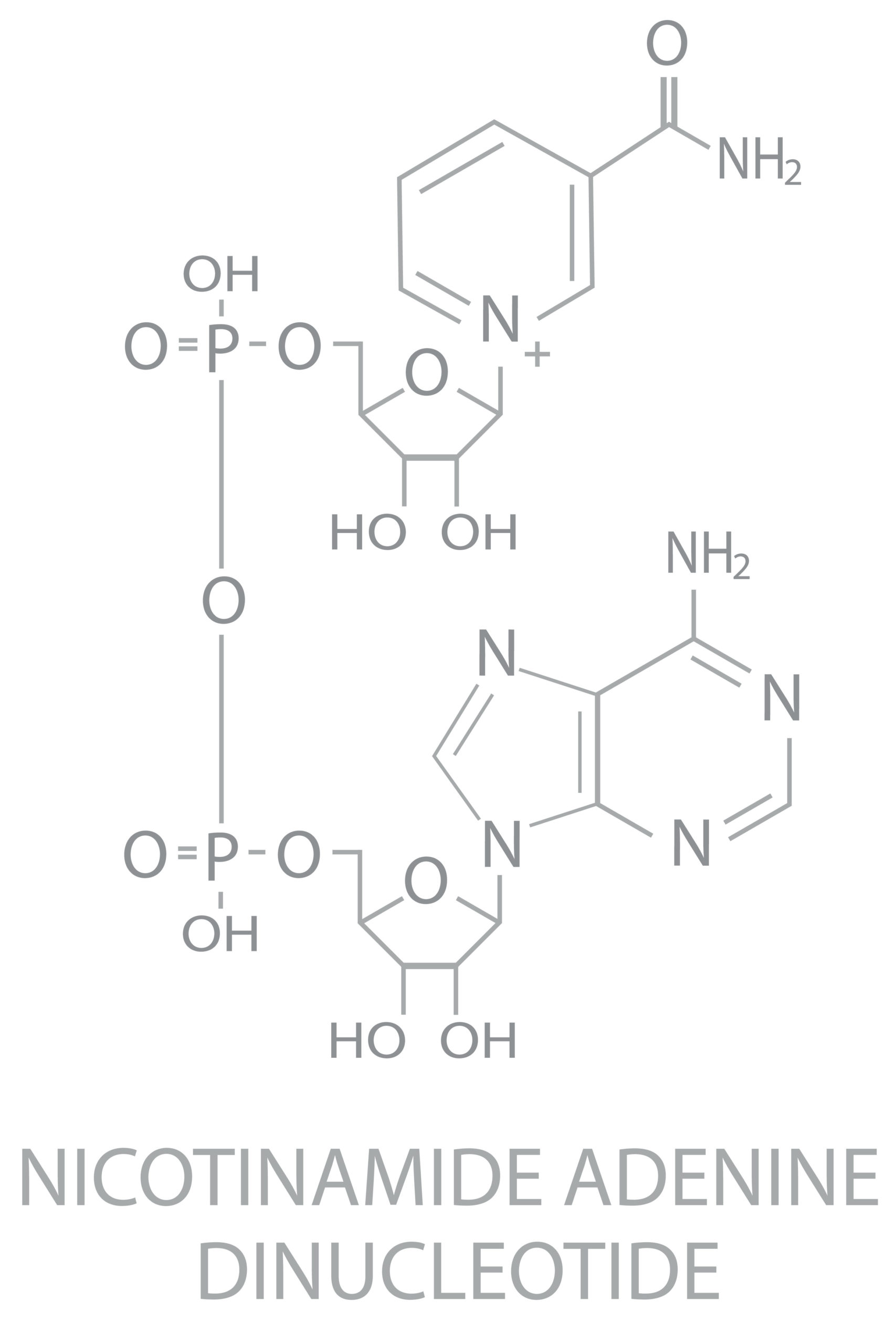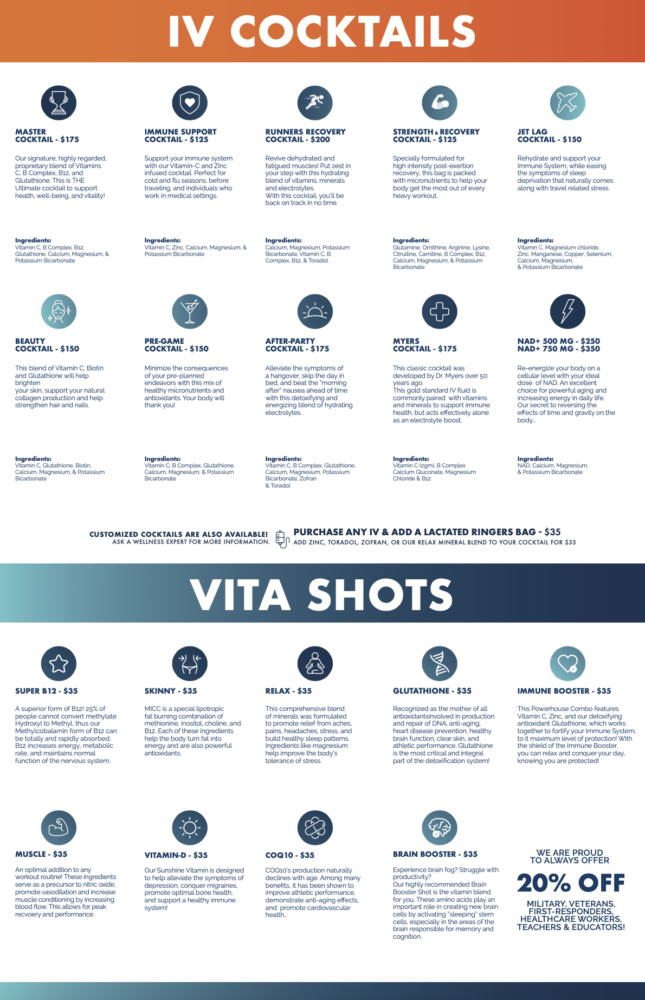NAD+- The Science Of Aging-
What is NAD+?
NAD stands for nicotinamide adenine dinucleotide. NAD+ is a coenzyme found in, and produced by, every living cell in your body. NAD has a role in regulating metabolism and your circadian rhythm (“body clock”). Recently, it has also been found to have a possible role in cellular longevity, oxidative metabolism, aging, and life span. It not only helps convert food to energy but also plays a crucial role in maintaining DNA integrity and ensures proper cell function to protect our bodies from aging. Recent research has been examining the use of NAD in the prevention and treatment of some diseases.
How does NAD+ work in the body?
It works to transfer and carry electrons from one molecule to another so that there can be all sorts of reactions and processes. NAD is a key ingredient for energy production within the human cell. When the cell has energy, it can perform its function. NAD is a key ingredient that is used by mitochondria to generate ATP. ATP is what produces energy in our body. Without sufficient NAD levels, our cells wouldn’t be able to generate the right amount of energy to survive and carry out the functions they need.
As you age, NAD levels drop
Unfortunately, after the age of 40, research states that NAD levels decline by over 50%. What this means is that the mitochondria does not have the necessary ingredients to generate sufficient energy. The damage to our DNA that comes with age activates several proteins, including PARPS. Consuming enough NAD will help PARPs to perform DNA repair functions.
There are many functions in the body that may require NAD but a lot of scientists believe that PARPS contributes to the most diseases. NAD also helps Sirtuins, which are the regulators of cell aging. In addition, NAD helps the function of poly (ADP-ribose) polymerases (PARPs) that play an active role in DNA repair. Together, they repair damaged cells and help mediate the aging process.
How do our cells make NAD+?
The process by which NAD is made is called biosynthesis. The three known pathways according to NCBI is:
- The kyneurenine pathway starts tryptophan. This essential amino acid often comes from food sources like meat, cheese, eggs, and fish.
- The Preiss-handler pathway begins with nicotinic acid. Nicotinic acid is usually found in food but can also be consumed through diet. One interesting fact is that it can also be produced by the bacterial microflora in the intestine or the saliva.
- The salvage pathway uses naturally occurring compounds related to the vitamin B3. This process involves nicotinamide’s conversion by an enzyme.
What happens when levels are reduced?
According to BMC, there is a connection that metabolism has to the depletion of NAD levels. These problems can lead to disorders, which includes obesity and insulin resistance. Because of this, there may be a possibility of diabetes and high blood pressure. Not only that but problems with metabolic disorders can send a rippling effect through the rest of the body. High blood pressure may send damaging pressure waves to the brain. This can lead to cognitive impairment.
Eurek Alert states that there is some though that when NAD levels decline, this can play a role in increased risk for cognitive diseases. The upside is that restoring those NAD levels may be able to reverse age related deficiencies in physiological function.
Potential Benefits
Keeping your NAD levels at a healthy level is important to many different functions in your body and even your health:
- Aging- As you may know, NAD is the fuel that drives your genes to work. A decrease in this will have the opposite effect that you want. There is positive evidence that this is true for animal models and scientists are now working on how this can connect with humans.
- Muscle Function- Mitochondria is crucial for our muscle function. NAD is one of the more important parts of the mitochondrial process. Increasing these levels can help improve fitness and may even allow for a leaner look in the body.
- Metabolic disorders- One of the most common diseases in modern society. According to the World Health Organization, it killed about 1.6 million people. When you age, this reduced the levels of NAD in the body resulting in slower metabolisms.
- Heart Function- High blood pressure causes by age can cause an enlarged heart and may even lead to strokes. When you boost NAD levels, this may help give protection to the heart, which can improve cardiac functions.
- Neurodegeneration- Aging can bring on many neurological disorders, one of them being Alzheimer’s. Studies say that increasing NAD levels may be able to decrease protein build up that disrupts the cell communication and may even increase cognitive function.
How to boost your levels and increase lifespan
One of the biggest benefits of NAD is that it may increase lifespan. Not only that but it may also provide positive protection against age related diseases. The good thing is that there are many ways to increase NAD levels in your body. One of the first things is to make sure you’re leading a healthy lifestyle. It is said that mild stress to your body in terms of fasting and exercise may be able to increase the production of NAD.
Another great thing to take into consideration is supplementation via IV. IV Therapy is a great way to get the right amount of nutrients that your body needs to function the right way. There are specialized treatments built to work with customers and provide them with a wider range of benefits to meet their needs.
At The IV Lounge we provide just that. Make sure to visit our website or give us a call to schedule your appointment today.







